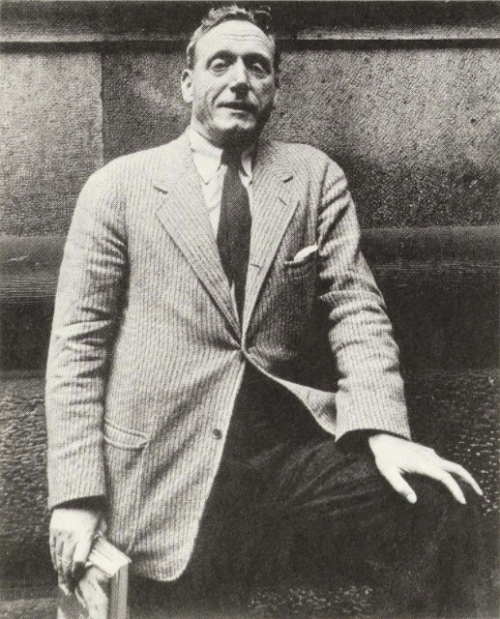
One of my greatest joys is visiting museums. I love museums of all kinds but I’m particularly fond of author museums. It should come as no surprise that my bias leans toward Southern authors. (And, if I break it down further, I’d say, I’m even fonder of Appalachian authors.) A few years ago, my husband and son took me on a birthday trip to Robert Penn Warren’s Birthplace and Museum in Guthrie, Kentucky. I’d like to share some of this journey with our readers.
Guthrie, Kentucky was once a booming railroad junction, named after United States Senator James A. Guthrie, a founder of the L&N Railroad and its president from 1860 to 1868. The senator was also “Franklin Pierce’s secretary of the Treasury from 1853 to 1857.”1)Rennick, R. M. (1984). Kentucky Place Names. Lexington: University Press of Kentucky. p. 127Located just north of Clarksville, Tennessee, the town had more than its fair share of violence. Robert Penn Warren’s lifelong friend, Major League Baseball player Kent Greenfield, said of Guthrie: “You wouldn’t believe the people in my lifetime that have been killed in this town. Shot. Cut up. Doctors come in here and stay overnight and say they’ve seen more blood than they’ve ever seen in their life.”2)Blotner, J. L. (1997). Robert Penn Warren. New York: Random House.p. 24
As soon as we entered Guthrie, we were faced with an old, perfectly preserved L&N railroad car, which, I’m guessing was a reminder of Guthrie’s namesake and railroad past.
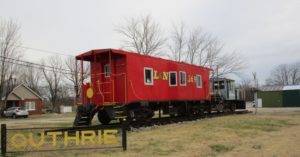
The streets were surprisingly wide and empty, and we reached our destination after just a few turns. Along Third and Cherry Street, a historical marker is dedicated to Robert Penn Warren. The mind reels in stunned admiration after reading the words: “summa cum laude,” and “the Fugitives,” and “Rhodes scholar,” and “Guggenheim Fellow,” and “First Poet Laureate of the United States,” and “a Pulitzer Prize in both fiction and poetry,” a distinction he won three times. Then, the eye gazes past the sign and there stands, as modest as can be, the Warren home. Robert Penn Warren himself was born in the house on April 24, 1905, the eldest son of Robert Franklin Warren and Ruth Penn Warren. The brickhouse has been remarkably well-maintained in its 1902 Victorian-esque style and it rests on about a quarter acre (if that much) of land. The surrounding fence is made of sturdy wrought iron.
Approaching the house, the small porch is an L-shaped nook. This spot is likely where Robert Penn Warren’s mother stood, calling him by his nickname, “Rob’ Penn,” “when he was big enough to play outdoors.”3)Blotner, J. L. (1997). Robert Penn Warren. New York: Random House., p. 9As time passed “Rob’Penn” became “Red” due to his fiery red locks.
The house’s glass windows have been well-preserved4)Selbert, P. (2005, Sept 11). Robert Penn Warren’s Kentucky home. Retrieved from Chicago Tribune.and special care was taken with the stained glass to keep it in its original condition. The structure has been largely kept in period form, though an added closed-in back porch was built by a later occupant.
The inside of the house is airy and friendly with an aura of sweet hospitality. The hardwood floors are original and the rooms are festooned with period curtains and wallpaper. The author’s visage adorns every room, as well as family photographs of his mother, father, brother, and sister. Several of his friends are also given prominent places in some of the rooms – from the Fugitives to Kent Greenfield.
Little Robert stayed in the home for only “four or five” years, but the family remained in Guthrie, Kentucky. Robert left for Tennessee’s Vanderbilt University at age sixteen. His scholarly endeavors (as mentioned on the historical marker) are strikingly impressive. Yet, all his literary successes may never have occurred if it weren’t for a tragic injury. The teenage Robert Penn Warren was visiting home before he was to be admitted to the United States Naval Academy. His younger brother, William Thomas Warren, was playing with lumps of coal in the driveway of the family’s more permanent home “a half mile from the center of Guthrie.”5)Blotner, J. L. (1997). Robert Penn Warren. New York: Random House. p. 24William flung a “base-ball size” lump of coal and it “sailed in an arc and landed directly on his brother’s left eye, knocking him unconscious.”6)Blotner, J. L. (1997). Robert Penn Warren. New York: Random House. p. 30
His father rushed him to a hospital in Clarksville, where doctors gave the grim news that the eye was forever damaged. Such an injury meant he “could not pass the physical examination again for admission [to the Naval Academy].”7)Blotner, J. L. (1997). Robert Penn Warren. New York: Random House.p. 30Instead, Penn Warren entered Vanderbilt University and the rest is history. Unfortunately, after some years, complications with the eye led to its removal.
Even before this incident, Robert’s life wasn’t any better, at least on a social level in Guthrie. Robert was extremely intelligent and intellectual even at a young age. He skipped several grades and was a straight-A student, all around. He excelled at painting and won prizes for several works. Yet, his achievements drew the jealous ire of local boys.
As Penn Warren states:
“Once some older and bigger boys got me in a deserted building . . . and put a rope around my neck and started pulling on it. They said they’d teach me about grade-making. They lifted me off my toes two or three times, to scare me. Then one of them, suddenly, got ashamed, or sick of what they were doing, and made them quit. Later one or two tried to apologize, and I said, ‘Go to hell.’”8)Blotner, J. L. (1997). Robert Penn Warren. New York: Random House. p. 26
When he was fifteen years old, he enrolled in Clarksville High School. Life was better in Clarksville and, with the exception of several ups and downs, he consistently rose throughout his life.
In 1947, Robert Penn Warren was awarded the Pulitzer Prize for Fiction for All the King’s Men.9)Francisco, Edward, Robert Vaughn, Linda Francisco, eds. (2001). The South in Perspective: An Anthology of Southern Literature. Upper Saddle River, New Jersey: Prentice Hall. p. 693The novel follows the political life of Willie Stark, a character inspired by politician Huey Long. Long was governor of Louisiana (1928-1932) and a United States Senator (1932- 1935). All the King’s Men was made into two films:
- 1949 (directed by Robert Rossen with Broderick Crawford playing Willie Stark)
- 2006 (directed by Steven Zaillian with Sean Penn playing Willie Stark).
In 1955, his novel Band of Angels also made it onto the silver screen. The novel is set in the Civil War era as heroine Amantha Starr’s race and ethnicity are called into question. The novel “is one of the most searing and vivid fictional accounts of the Civil War era ever written.” The movie stars Yvonne De Carlo (think Lily Munster) as Amantha Starr and Clark Gable as Hamish Bond.
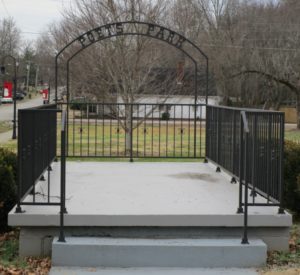
Penn Warren won the Pulitzer Prize for Poetry twice: Promises (1957) and Now and Then (1979).10)Francisco, Edward, Robert Vaughn, Linda Francisco, eds. (2001). The South in Perspective: An Anthology of Southern Literature. Upper Saddle River, New Jersey: Prentice Hall. p. 692-69311)Blotner, J. L. (1997). Robert Penn Warren. New York: Random House. p. xv
The Robert Penn Warren Birthplace and Museum is a very welcoming and friendly place. Free items (bookmarks, postcards, etc.), along with items to buy are offered. The prices are extremely reasonable. For around twenty dollars, I purchased a few bumper stickers, and the following titles:
- World Enough and Time (1949)
- Wilderness: A Tale of the Civil War (1961)
- Flood: A Romance of Our Time (1964)
- Meet Me in the Green Glen (1971)
- A Place to Come Home To (1977)
So, how did it feel being there? Well, I’d need to explain a little quirk of mine, first. I have mostly been a person who considers the earth I walk upon. When I was a little girl traipsing through the holler, I often thought about the Native Americans who clearly lived on the land before I did. (I say “clearly” because so much evidence points to that fact – from arrowheads to drawings in caves.) With every thought, I visualized their ancient footsteps and how my little footprint walked with them. When I walked around a place called Shown Holler (Shown being my maiden name, and, incidentally, it’s pronounced like brown), I envisioned the tracks of my ancestors from hundreds of years before. When I attended the University of Tennessee and walked along and around Humanities, I visualized Cormac McCarthy’s or Ed Francisco’s or Alex Haley’s footsteps. I had the same feeling at Robert Penn Warren’s museum. Although he spent such a short period of time there, an excited little shiver ran through me when I thought about his small steps there, or imagined his little boy laughter ringing through the place, or saw his mother standing there smiling in a long Edwardian dress at the porch, her young hair in a Gibson-girl knot, perhaps pushing aside a stray strand or two, calling for “Rob’Penn.”
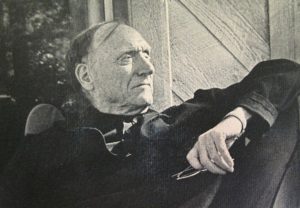
**Featured Image: Outside the Robert Penn Warren Birthplace and Museum, photograph taken by Tom Anderson
References
| ↑1 | Rennick, R. M. (1984). Kentucky Place Names. Lexington: University Press of Kentucky. p. 127 |
|---|---|
| ↑2 | Blotner, J. L. (1997). Robert Penn Warren. New York: Random House.p. 24 |
| ↑3 | Blotner, J. L. (1997). Robert Penn Warren. New York: Random House., p. 9 |
| ↑4 | Selbert, P. (2005, Sept 11). Robert Penn Warren’s Kentucky home. Retrieved from Chicago Tribune. |
| ↑5 | Blotner, J. L. (1997). Robert Penn Warren. New York: Random House. p. 24 |
| ↑6 | Blotner, J. L. (1997). Robert Penn Warren. New York: Random House. p. 30 |
| ↑7 | Blotner, J. L. (1997). Robert Penn Warren. New York: Random House.p. 30 |
| ↑8 | Blotner, J. L. (1997). Robert Penn Warren. New York: Random House. p. 26 |
| ↑9 | Francisco, Edward, Robert Vaughn, Linda Francisco, eds. (2001). The South in Perspective: An Anthology of Southern Literature. Upper Saddle River, New Jersey: Prentice Hall. p. 693 |
| ↑10 | Francisco, Edward, Robert Vaughn, Linda Francisco, eds. (2001). The South in Perspective: An Anthology of Southern Literature. Upper Saddle River, New Jersey: Prentice Hall. p. 692-693 |
| ↑11 | Blotner, J. L. (1997). Robert Penn Warren. New York: Random House. p. xv |
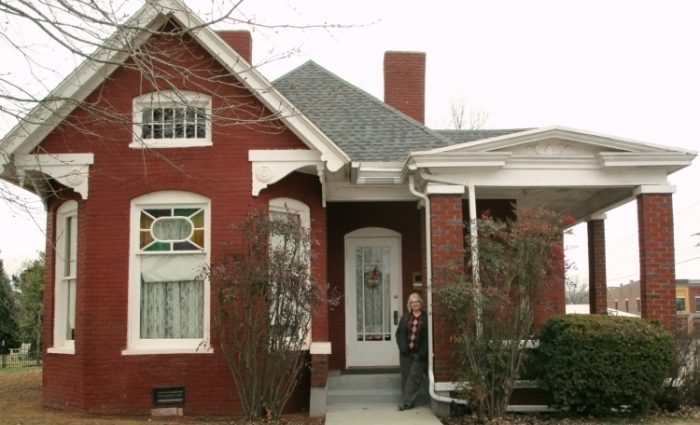















While I read All the King’s Men years ago, I was otherwise sadly ignorant of the breadth of Warren’s works. Thanks for this tour and fascinating survey of his life and writings.
I’m glad you liked the tour. I really enjoyed the venture and it was such a wonderful birthday gift. He wrote in so many genres and one stands in awe of the works he accomplished. I’m currently reading World Enough and Time, which is a historical fiction based on a real incident called “The Kentucky Tragedy.” I find the novel is quite beautifully written and his poetic style certainly comes through. But, of course, that’s no surprise at all.